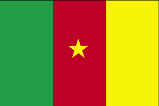|
Cameroon
|

|
Capital: Yaounde
Population: 25,876,380
Brief History of Cameroon:
The first settlers in the land of Cameroon were hunter-gatherer people such as the Baka and the Sao.
The first Europeans to arrive were the Portuguese in 1472. The sailors found a lot of shrimp in the rivers and started calling the land the Rio dos Camar?es or River of Shrimp. From this phrase Camaroon got its name. For some time the Portuguese only explored the coast.
In the late 1700's the Fulani people invaded and conquered the land. They brought the Islamic religion with them.
\In 1884 the German colony of Kamerun was established. It remained German until after World War I when it was split up between Britain and France. In 1960 the French portion of Cameroon gained its independence. A few years later a portion of British Cameroon joined Nigeria and the rest joined with the Federal Republic of Cameroon.
The Geography of Cameroon
Total Size: 475,440 square km
Size Comparison: slightly larger than California
Geographical Coordinates: 6 00 N, 12 00 E
World Region or Continent: Africa
General Terrain: diverse, with coastal plain in southwest, dissected plateau in center, mountains in west, plains in north
Geographical Low Point: Atlantic Ocean 0 m
Geographical High Point: Fako 4,095 m (on Mt. Cameroon)
Climate: varies with terrain, from tropical along coast to semiarid and hot in north
Major cities: Douala 2.053 million; YAOUNDE (capital) 1.739 million (2009), Garoua, Bafoussam
The People of Cameroon
Type of Government: republic; multiparty presidential regime
Languages Spoken: 24 major African language groups, English (official), French (official)
Independence: 1 January 1960 (from French-administered UN trusteeship)
National Holiday: Republic Day (National Day), 20 May (1972)
Nationality: Cameroonian(s)
Religions: indigenous beliefs 40%, Christian 40%, Muslim 20%
National Symbol: lion
National Anthem or Song: O Cameroun, Berceau de nos Ancetres (O Cameroon, Cradle of Our Forefathers)
Economy of Cameroon
Major Industries: petroleum production and refining, aluminum production, food processing, light consumer goods, textiles, lumber, ship repair
Agricultural Products: coffee, cocoa, cotton, rubber, bananas, oilseed, grains, root starches; livestock; timber
Natural Resources: petroleum, bauxite, iron ore, timber, hydropower
Major Exports: crude oil and petroleum products, lumber, cocoa beans, aluminum, coffee, cotton
Major Imports: machinery, electrical equipment, transport equipment, fuel, food
Currency: Communaute Financiere Africaine franc (XAF); note - responsible authority is the Bank of the Central
National GDP: $47,300,000,000
** Source for population (2012 est.) and GDP (2011 est.) is CIA World Factbook.
Back to Geography Home Page
